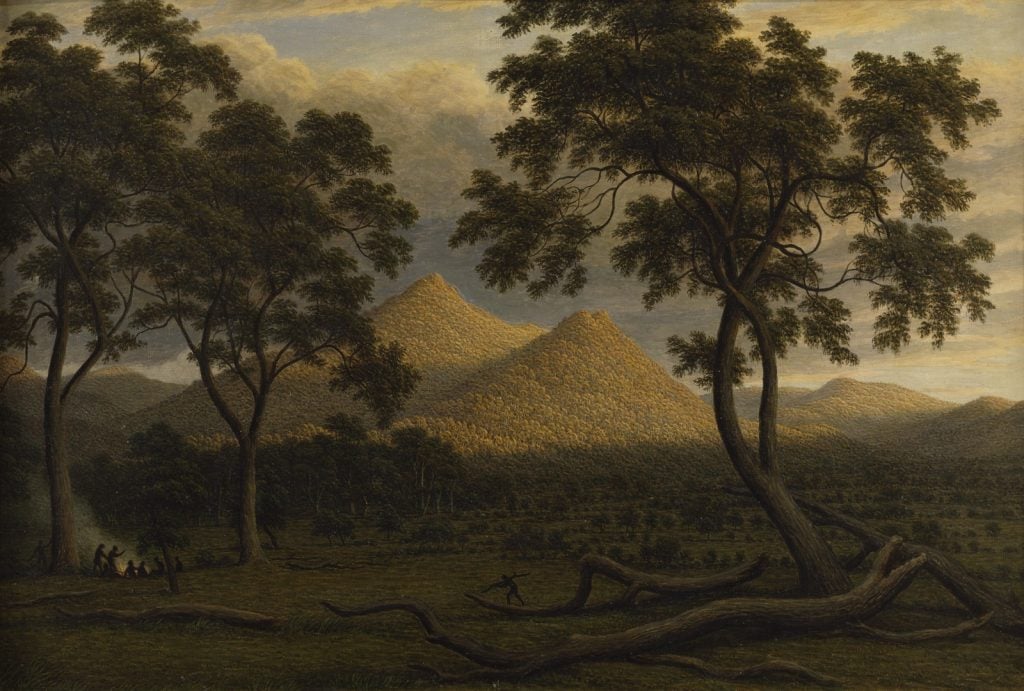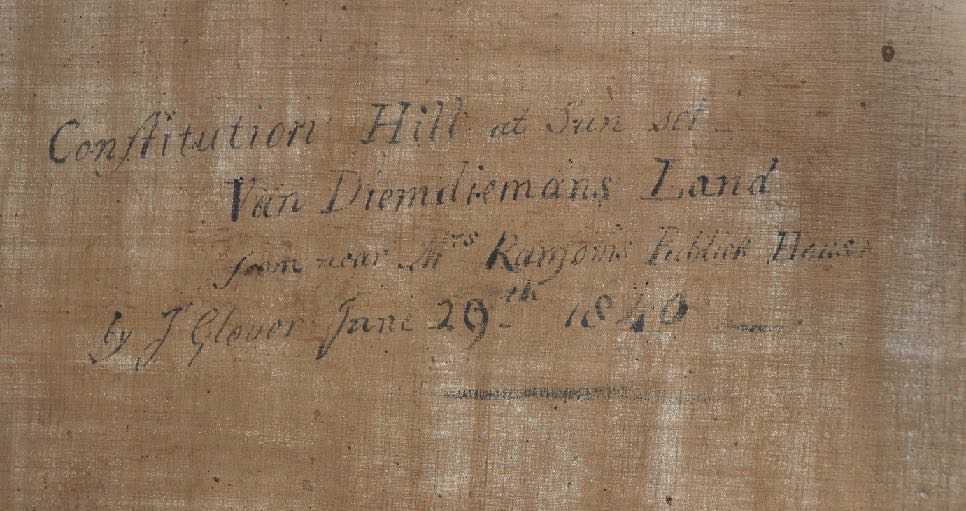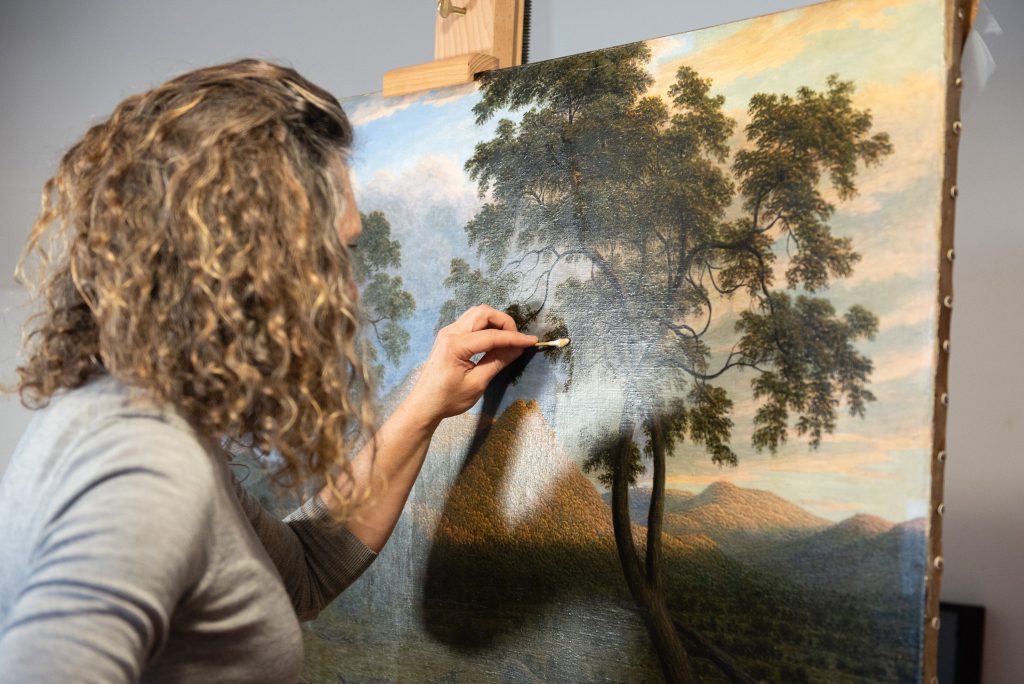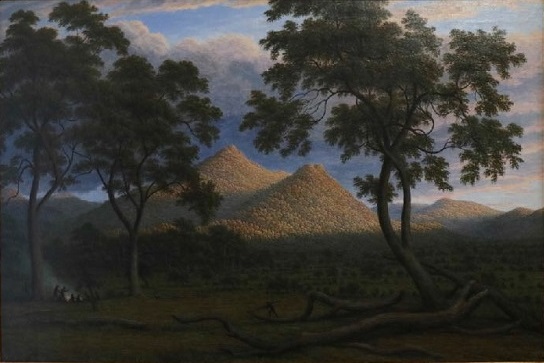
Introduction
During the Library closure, Collection Care had the opportunity of attending to the conservation treatment of one of the Library’s iconic paintings, Constitution Hill at Sun set Van Diemdiemans [i.e. Diemen’s] Land from near Mrs Ransoms Publick House Jane [June or January] 29th 1840 by colonial artist John Glover. The natural resin varnish on the painting had aged and become dull and yellowed, masking the original colours of the oil paint. Recent conservation treatment has transformed its appearance and inspired a new appreciation of this important work.
John Glover (1767-1849), was a successful European landscape painter, when he emigrated with family to Van Diemen’s Land in 1831, at the age of 64. Three of his sons were already settled there. He was a well-travelled, adventurous, amateur naturalist with a desire to establish a farm and discover a new world to paint. In 1832, Glover was allocated a land grant on the Nile river on the north side of Ben Lomond, in the Tasmanian midlands. He called his property Patterdale and it was here that he painted and developed the property with his family.
He was documenting the pastoralists’ colonial frontier, albeit with a measure of artistic license, to depict a picturesque arcadia for the benefit of less travelled British eyes. At the time of Glover’s arrival in Tasmania, the decimation of the Indigenous people was far advanced and documented in the local papers. He had limited contact with the few remaining Palawa people, however, was known to have drawn portraits of Indigenous people held in gaol. His representation of them in his landscapes even then, harked back to an earlier less disturbed time.
Glover died aged 82 in 1849, however he was not recognised as a remarkable and collectable Australian landscape painter, outside of Tasmania, for another 100 years.

Before treatment, showing marked overall discolouration of the varnish.
The painting (history)
Glover’s Constitution Hill at Sun set is possibly one of the last works he painted, as his sight was failing in later life. It depicts Constitution Hill in a soft evening light, with spreading shadows. In the midground, there is a group of Aboriginal people gathering wood and sitting around a fire. Constitution Hill is located 40 km from Hobart on the old road to Launceston, near the town of Bagdad. In the days of the horse and carriage, Bagdad was a changing station for those continuing their journey up Constitution Hill or onto Launceston.
Provenance
This painting was generously donated to the Library in 1954 from the estate of Janet Biddlecombe (nee Russell). It hangs in Cowen Gallery and is one of the treasures of the Library’s painting collection. In a previous life, it hung in the grand dining room of the Russell pastoral estate ‘Golf Hill’, near Shelford in the Victorian shire of Golden Plains. It would be interesting to know when the painting was transported across Bass Strait, making its way to the Russell family estate.
Description
The title and date of the painting are taken from ink inscriptions on the back of the canvas:
Constitution Hill at Sun set / Van Diemdiemans Land / from near Mrs Ransoms Publick House / by J Glover Jane 29th 1840

Characteristic of Glover’s style, the oil paint has been thinly applied to the linen canvas in a series of washes, in a manner similar to watercolour.
The frame is a fine contemporary gilded timber and gesso frame, which appears to be original.
Condition
The overall condition of the painting and frame was generally very good, testament to the quality of materials used by Glover in the far reaches of colonial Tasmania, but also the care taken to preserve the painting since.
The exception was that the original varnish, now 180 years old, a natural aged resin varnish protecting the oil paint, had reached the end of its useful life. The varnish was so dull and discoloured that it was masking the original colours of the paint.

Treatment
This painting was removed from display, crated and sent to Paintings Conservator Helen Gill of Helen Gill, Art Conservation who undertook the treatment, made possible with generous support of the Marquill Foundation.
According to Helen, it was one of those treatments which transforms the appearance of the work. After experienced testing to select the correct solvent, the aged vanish was painstakingly removed, slowly revealing a colour balance closer to what it would have looked like when it was originally painted.

In the treatment images, the left-hand side has been cleaned and the right-hand side remains untouched. The colours are noticeably brighter where the varnish layer has been removed. The colour of the varnish can also be seen on the cotton wool swab as it is removed, section by section. Many fine details and brush strokes were revealed as a result of the treatment, adding to the viewer’s experience of the work.

Once cleaning was complete, the painting was varnished with a newly developed clear varnish , designed by the CSIRO and the NGV. This clear coating will re-saturate the oil colours and protect the paint layers for another 100 years.
Following successful treatment, the painting is now back on public display in Cowen Gallery looking as fresh and vivid as the day it was painted.


Notes
The records of the Russell family are held in the Australian Manuscripts Collection. Portraits of members of the Russell family, as well as furniture from their home ‘Golf Hill’, are located in the Picture Collection.
Contemporary newspaper articles referring to the life led by John Glover in Tasmania can be found searching Trove, such as;
- A note in an 1831 article in The Hobart Town Courier on the arrival of the renowned artist John Glover to Hobart, to join his family already settled there.
- A record from 1832 of two paintings done in Tasmania by Glover and sent to the UK British Artists Society exhibition in The Colonist and Van Diemen’s Land Commercial and Agricultural Advertiser
- Obituary from The Courier newspaper in 1849 – Mr Glover, The Artist.
- Another obituary from the 1850 Launceston Examiner – John Glover. The Artist, which includes a glowing expose of his life in Tasmania, such as apparently being the first person who travelled to the summit of Ben Lomond, and in the company of John Batman, who was a neighbour.
Further Reading
Hansen, David, 2003, John Glover and the Colonial picturesque, Tasmanian Museum and Art Gallery, Hobart. AF 759.994 G51H
Hansen, D, 2003, John Glover: the Van Diemen’s Land sketchbook of 1832-1834. A 759.994 G51HA
McPhee, J, 1977, John Glover, Queen Victoria Museum and Art Gallery, Launceston. A 759.994 G51M
McPhee, J, 1980, The art of John Glover, Macmillan, Melbourne. AO 759.994 G51A
Ryan, L, 2012, Tasmanian Aborigines: a history since 1803, Allen Unwin, Crows Nest. LT 994.60049915 R95T
Walker, S, 2016, Enterprise, risk and ruin: the stage-coach and the development of Van Diemen’s Land and Tasmania, Fullers Bookshop, Hobart. LT 388.34109946 W1541E


Jane – wonderful piece!
How wonderful that we may now see the painting as the artist intended. Congratulations, Helen Gill.
Thankyou for sharing this, such a lovely painting
THANKYOU so much. A fascinating and very informative article regarding the background and process of conservation of this beautiful and historic art work. Much Appreciated
OMG – what a startling difference. It has come to life again. A fantastic job completed in such a downtime.
It’s wonderful to know about it’s conservation and to see it. I’ll come in again to take a closer look. I also note that a generous donor made its conservation possible. Where would we be without such people?!
That’s very true Fran. Please do visit again.
Really interesting item thank you but John Glover (and that thug John Batman) would surely not be the first to climb Ben Lomond – maybe the first Europeans??????
Hi Ann, that information is a contemporary quote taken from an 1850 newspaper. The link in the text will take you straight to the article on Trove.
The John Glover painting Constitution hill was originally owned by the Rev Robert Russell of Evandale . It was bequeathed to William Lewis who was the ‘carer ‘ for the Rev .
William Lewis sent the painting to Golf Hill